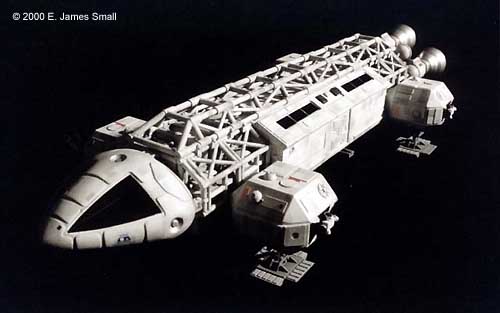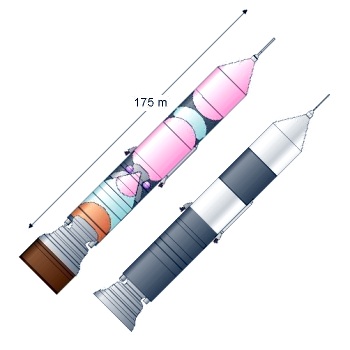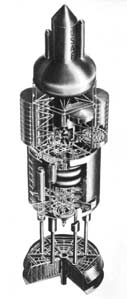

We should have seen a lot more of this by now. Instead we get invitations to bid on janitorial services and road maintenance.

If they took all of the money they are going to spend on this (and I'm sure the big aerospace companies and various Senators and Representatives are going to lobby hard for a lot of money) and split it among any company that can meet the X-Prize criteria one year from now (including Rutan's group that won it last year). It'd probably go a lot further, have less chance of being wasted (large companies plus the government plus large projects have way too much mission and budget creep), and it could even give us multiple spacecraft to get to the Moon - even better.
Send all the RATs tolonize the Moon - Moonskie Socialist Sky Union and have only gay marriages allowed.
Cool stuff. Git-r-done.

I made a few good paper planes at school that I used to throw off the top floor of the science building. Where do I apply ?

FUTURE LAUNCH VEHICLE PLANS [1963-2001]
DETAILS ON SEA DRAGON
Sea Dragon was a two-stage design of 1962 capable of putting 1.2 million pounds (550 tonnes) into low Earth orbit. The concept was to achieve minimum launch costs through lower development and production costs. This meant accepting a larger booster with a lower performance propulsion system and higher stage dead weight then traditional NASA and USAF designs. The first stage had a single pressure fed, thrust chamber of 36 million kgf thrust, burning LOX/Kerosene. The second stage was ‘considerably smaller’ (thrust only 6.35 million kgf!) and burned LOX/LH2. The complete vehicle was 23 m in diameter and 150 m long. The all-up weight was 18,000 tonnes. The launch vehicle would be fuelled with RP-1 kerosene in port, then towed horizontally to a launch point in the open ocean. It would then be filled with cryogenic liquid oxygen and hydrogen from tankers or produced by electrolysis of sea water by a nuclear aircraft carrier (such as the CVN Enterprise in the painting). After fuelling, the tanks at the launcher base would be flooded, and the vehicle would reach a vertical position in the open ocean. Launch would follow. The concept was proven with tests of the earlier Sea Bee and Sea Horse vehicles. Aside from the baseline two stage expendable version, a single-stage-to-orbit reusable vehicle with a plug nozzle was designed. Costs to low earth orbit were estimated to be between $60/kg and $600/kg - eg one fourth that of the Saturn V or less.
Stage one used liquid nitrogen to force the propellants into the engine. At ignition, combustion chamber pressure was 20 atmospheres, and kerosene was forced into the chamber at a pressure of 32 atmospheres and liquid oxygen at 17 atmospheres. By burnout 81 seconds later combustion chamber pressure had declined to 14 atmospheres, kerosene feed pressure to 20 atmospheres, and liquid oxygen pressure to 8.5 atmospheres. At burnout the stage had reached a velocity of 1.8 km/second at an altitude of 40 km and a range of 33 km. After separation the stage would impact the ocean 290 km downrange (one alternate was recovery and reuse of the stage). Losses due to gravity and drag were minimised by the high 2:1 thrust-to-weight ratio and low drag losses (deceleration at max q was about 0.2 G’s ) resulting from the large size of the booster.
Stage two had a burn time of 260 seconds and a low constant combustion chamber pressure of 7 atmospheres. The stage achieved a total delta V of 5.8 km/second, shutting down at orbital velocity at an altitude of 230 km and 940 km downrange from the launch point. A significant feature of the concept was the use of an expandable nozzle exit cone. This increased the area ratio of the nozzle from 7:1 to 27:1 when deployed. Initial tests showed considerable promise, but development ceased because of lack of in-house funding. This concept was later fully developed under the solid rocket Peacekeeper program.
The design was reviewed with Todd Shipyards, who concluded that it was well within their capabilities, and not too unlike making a submarine hull. 8 mm thick maraging steel was used, similar to the Aerojet 260 inch solid motor of the time. NASA Marshall gave the Aerojet designs to TRW for evaluation. TRW fully confirmed Aerojet's costs and engineering, a great surprise to both TRW and NASA. Aerojet was considering purchasing Sudden Ranch as a launch site for Sea Dragon. This property included several kilometres of coastline between Santa Barbara and Vandenberg AFB. This was the only site on the continental United States that could launch directly into a polar orbit without overflying populated areas (and was later incorporated into Vandenberg).
But this came just as Apollo was being cut back and the Viet Nam war was eating an ever greater amount of the US budget. NASA dissolved their Future Projects Branch (dropping almost all the manned Mars landing work). Prospects for Sea Dragon essentially disappeared, and Aerojet could no longer fund it on IR&D.

Project Orion: Its Life, Death, and Possible Rebirth
More technology we could use
In other words, one can produce a continuous controlled nuclear explosion in the region just behind the nuclear rocket. At this point the water of the fuel liquid flashes to very high temperature steam, expelling reaction mass with an estimated exhaust velocity of 66,000 meters per second (as compared with perhaps 4,500 m/s for a chemical rocket). The NSWR engine is calculated to produce a thrust of almost 3 million pounds (1.3 x 107 N) and to have a power output of 427 gigawatts. With this kind of performance, the mission to Titan could be launched from low earth orbit with an acceleration of almost 4 g's and could, in principle, be carried out with low launch mass, low cost and high efficiency.
About time the US is serious about going to the moon again.
bump
